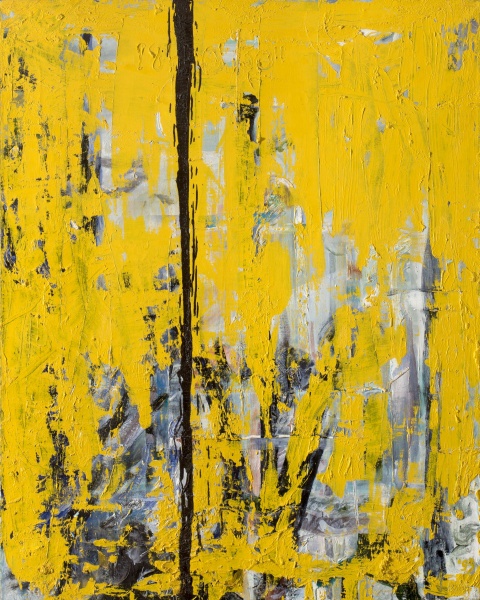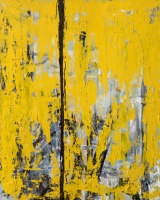
Yellow
| Author: | Linas Katinas (1941–2020) |
Linas Katinas was born on 22 June 1941 in Radviliškis. He is a painter and teacher, and the son of the artist Leonas Katinas. He studied in the Faculty of Architecture of the State Art Institute of Lithuania from 1958 to 1964, and between 1968 and 1992 he worked as a teacher at the National M.K. Čiurlionis School of Arts. He began to teach painting in the Textiles Department of Vilnius Academy of Art in 1992. He has participated in exhibitions since 1964, and is a member of Group 24. He has produced some stage sets, and held solo exhibitions in Vilnius (1967, 1968, 1974, 1984, 1986, 1988, 1990, 1993, 1996), Tallinn (1973), and Charlottesville (USA, 1974), and participated in group exhibitions in Sweden, Germany, France, Hungary, Russia, England and Latvia. He won the National Prize for Culture and Art in 1999.
Linas Katinas’ work is related to Expressionism, and he has worked in various techniques. He later chose abstractionism, produced installations, and used elements of conceptual art. He has used Lithuanian folk motifs skilfully in his compositions, and later features of Buddhist art, which he combined with Western art. Pictograms, hieroglyphics and quotes recur quite frequently in his work of the last decade. Some of his works have been acquired by the Lithuanian Art Museum and the M.K. Čiurlionis National Art Museum.
L. Katinas studied architecture, but his temperament, his huge inner energy and his creativity propelled him into painting. The evolution of his art was rapid: from expressive painting in dark colouring to abstract works. The works in a geometric style that emerged from his studies of Lithuanian folk decoration were particularly distinguished in his evolutionary path, and helped him to retreat from visible reality. These works were influenced by his interest in oriental culture. He finally turned to abstract painting, which sometimes has Surrealist features or hints of Surrealism.
Source: Valiunas Ellex (LAWIN until 2015) art album: THE WORLD OF LANDSCAPES II (2013). Compiler and author Nijolė Tumėnienė.

Linas Katinas was born on 22 June 1941 in Radviliškis. He is a painter and teacher, and the son of the artist Leonas Katinas. He studied in the Faculty of Architecture of the State Art Institute of Lithuania from 1958 to 1964, and between 1968 and 1992 he worked as a teacher at the National M.K. Čiurlionis School of Arts. He began to teach painting in the Textiles Department of Vilnius Academy of Art in 1992. He has participated in exhibitions since 1964, and is a member of Group 24. He has produced some stage sets, and held solo exhibitions in Vilnius (1967, 1968, 1974, 1984, 1986, 1988, 1990, 1993, 1996), Tallinn (1973), and Charlottesville (USA, 1974), and participated in group exhibitions in Sweden, Germany, France, Hungary, Russia, England and Latvia. He won the National Prize for Culture and Art in 1999.
Linas Katinas’ work is related to Expressionism, and he has worked in various techniques. He later chose abstractionism, produced installations, and used elements of conceptual art. He has used Lithuanian folk motifs skilfully in his compositions, and later features of Buddhist art, which he combined with Western art. Pictograms, hieroglyphics and quotes recur quite frequently in his work of the last decade. Some of his works have been acquired by the Lithuanian Art Museum and the M.K. Čiurlionis National Art Museum.
L. Katinas studied architecture, but his temperament, his huge inner energy and his creativity propelled him into painting. The evolution of his art was rapid: from expressive painting in dark colouring to abstract works. The works in a geometric style that emerged from his studies of Lithuanian folk decoration were particularly distinguished in his evolutionary path, and helped him to retreat from visible reality. These works were influenced by his interest in oriental culture. He finally turned to abstract painting, which sometimes has Surrealist features or hints of Surrealism.
Source: Valiunas Ellex (LAWIN until 2015) art album: THE WORLD OF LANDSCAPES II (2013). Compiler and author Nijolė Tumėnienė.






